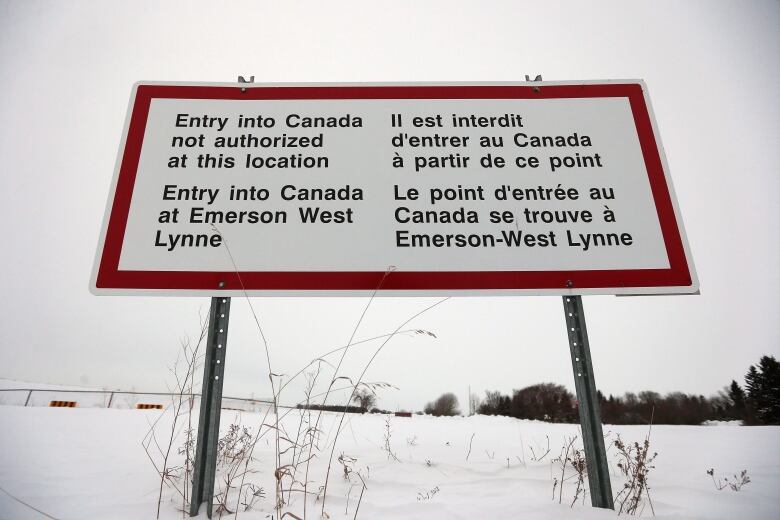U.S. needs to be 'much more vigilant' to stem flow of asylum seekers: security expert
RCMP working with U.S. counterparts to control claimants sneaking across border, security expert says

CanadianandU.S. officialsneed to co-ordinate their efforts to help stem the flow of would-be refugee claimants sneaking into Canada, which includes beefing up patrols on roads heading north to the border, says one security expert.
"Basically we need to make sure we work withU.S. border patroland state troopers to try to interceptsuspiciousvehicles long before they make it to the border," saidChristianLeuprecht, a political science professor at the Royal Military College of Canada and Queen's University.
"We need to work with local agencies to make sure they're much more vigilant, that when they see vehicles that might look like theymight not fit a standard patternin thatparticulararea, that they pull them over, they see what's going on."
The increase of would-be refugee claimants sneaking into Canada from the U.S. has raisedquestions about whether more needs to bedone to beef up bordersecurity in both countries. In recent weeks, dozens from the U.S. seeking asylumhave hiked throughthe snowy fields tocross the border near the town of Emerson, Man.

Setting up checkpoints in the U.S. along roads headingto Emerson may deter some asylumseekers from crossing into Canada, Leuprechtsaid. But it's unlikely to stem the flow.
"We would probably just displace the flow to one of the smaller crossings," he said.
"Because of the nature of the border and the number of crossings, Idon't think that's realisticallyfeasible, but it would act as a bit of a deterrent."
'Quiet discussions'
Instead, theRCMPcouldworkwith U.S. border patrol agentsto strengthen enforcement on U.S. roads near the Emerson crossing, he said.
"I suspect that's the quiet discussions theRCMPwill already be having with [U.S.] border patrol."

On the Canadian side, the Canada Border Services Agency is responsible for security at official points of entry. However,theRCMPis tasked with patrolling the large areasbetween them.
In atownhallmeeting in Emerson last week,RCMPspokeswoman TaraSeelconfirmed that the force has "allocated resources to that area" and that officers are working very closely "with ourpartnersacross the border."
"We do have technology, we do have patrols, we do have an integratedborder enforcement team, we have detachments acrosstheborder," Seel said.
- 'Desperate journey: How oneman snuck across the U.S.-Canada border
- 'Informal' network helping refuge seekers get to Manitoba, U.S. officials say
It is a challenge, though, consideringthey are responsible for patrolling over 500 kilometres of border in Manitoba.
"It is quite an extensive region that we are responsiblefor, but wedo have resources in place that are necessary," she said.
Leuprecht said both the Canadians and Americans have an interest in making sure those who seek to cross illegally into each other's country are apprehended.
Each other's best partners
'The basic premise is we're each other's friends and we're each other's best partners," Leuprecht said. "So anyone who crosses north to south or south to north outside of a port of entry [that's]conduct that is not in the interest of either country."

According to U.S. law, the area within 80 kilometres of a U.S. border is considereda border zone, meaning any law enforcement agency can stop anyone there and askfor identification oraskwhat they're doing.
"So U.S. border patrol is an important partner in this effort," Leuprecht said.
Topatrol the border on the Prairies,the U.S. relies on drones, said Leuprecht. During the day, there's permanent drone surveillance, meaningmanyasylum seekers who want to avoid border postsare more likely to cross at night.
Infrared technologyis used to patrol the border, but at night it's muchmore difficult to detect people. Heat signatures also can be traced butby the time they are detected, it's usually too late, and people are already out in a field somewhere, Leuprecht said.
"So, people cross at night because they know during theday, they will be apprehended by border patrol."
Threat called unlikely
University of Ottawa professor andsecurity expert Wesley Wark said he doesn'tbelieve the relatively small number of people crossing the border so far hasany securityimplications.
He said he doesn't believe Canada should worry about organized terrorists whowouldtry to exploit these routes to get into Canada.
"In terms of nefariousactivity, whether it's terrorist related or peoplesmuggling or drugsmuggling or anything like that, the remoteness and the difficulty of crossing the border in these kinds of ways I think largely rules that out."












_(720p).jpg)


 OFFICIAL HD MUSIC VIDEO.jpg)
.jpg)



























































































